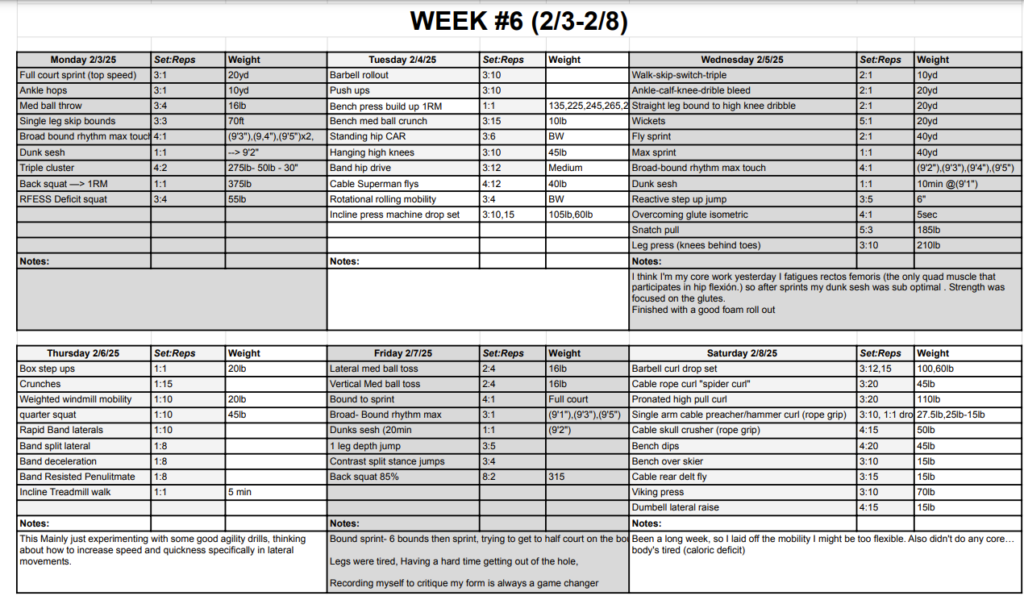So, here we are—week 6 of my vertical jump and dunking journey. Things have been moving, but let’s be real, I’m tired. Not the “oh, I did a couple of extra sets and feel tired” kind of tired, but the “I’m running on fumes and trying to convince my body to do plyos at 5 AM” kind of tired. But hey, the grind doesn’t stop, right?
Plyometric Days: The Usual Jumping Around, But With a Twist
Monday, Wednesday, and Friday were my plyometric days. These sessions are always intense, but I’ve got a little trick up my sleeve now: med ball throws. I’ve been incorporating them at the start of my plyo workouts to set up my body for the explosive moves to come. This little addition is based on a principle known as Post Activation Potentiation (PAP), which basically means I’m trying to fire up my nervous system by doing some heavy-resisted, explosive lifts before jumping into the lighter, higher-intensity plyos.
In short: lift heavy, then jump high. And it works.
PAP has been backed by research, with one study from Journal of Strength and Conditioning Research (2016) suggesting that “pre-loading” your muscles with a heavier resistance right before doing explosive activities can lead to greater force production and enhanced performance in jumps and sprints. So, that’s what I’m banking on. Med ball throws to warm up, then bam—into the plyos, trying to go higher with every rep. Honestly, though, this kind of explosive training really only works if you’re giving 100%. Which brings me to my next point…
Fatigue: A Constant Companion
This week, though, that 100% was harder to give than usual. Between late nights finishing assignments for school and those oh-so-early 4:30 AM wake-ups to get my workouts in, my energy levels have been scraping the bottom of the barrel. The workout intensity has been there, but my body’s not really following orders. I push through the best I can, but you can only be so explosive when your body feels like it’s running on empty. And let’s be honest, the mental fight is just as draining as the physical one.
But hey, that’s what this journey is all about, right? Pushing through when things get tough.
Arm Workout: Some Wins, Some… Not So Much
Saturday rolled around, and it was time for my arm workout. I made a few adjustments, which is always a gamble. Some things went great, and others… not so much.
I kept the cable preacher curls because those things just hit my biceps like a freight train. If you’ve never tried them, trust me, you’re missing out. The activation is on point. But the shoulder work, oh boy. Shoulders are tough to train. They’re like that one person in the group project who can’t ever seem to pull their weight, no matter how hard you try.
Here’s the thing: when you try to overload the shoulders too much, you end up recruiting the trapezius, levator scapulae, and a bunch of other muscle groups that aren’t supposed to be involved in your shoulder work. It’s like trying to do a plank, but instead of engaging your core, you start shaking your arms like a spaghetti noodle. So, to properly train the shoulders, the key is finding that sweet spot where the weight is heavy enough to challenge the muscle without getting all these rogue muscles involved. But finding that sweet spot is tricky—too light, and it doesn’t work; too heavy, and you’re doing more harm than good. It’s a delicate balance.
I’ve been reading some expert opinions on this, and as National Academy of Sports Medicine expert Dr. Mike Reiman says, “To effectively target the deltoids, you need to ensure you’re using appropriate resistance—one that activates the shoulder without overloading accessory muscles like the traps or upper back.” So, yeah, I’ll be adjusting my weights next time, but it’s a process.
The Struggle of Training When You’re Exhausted
Let’s face it, training when you’re exhausted is one of the hardest things to do, especially with plyometrics. You need that max effort to see progress, but your body’s like, “Yeah, no thanks, I’ll sit this one out.” It’s a tough spot to be in because you want to give it everything, but the body’s like, “Hey, remember that assignment you stayed up until 2 AM finishing? Yeah, I’m still tired from that.” I can’t skip the work, but I also can’t ignore the fatigue. It’s all about pushing through and finding ways to optimize what I can while I’m running on fumes.
But that’s the thing about a journey like this—it’s not just about the physical training. It’s about learning how to balance all the other demands in life, keeping your mind focused, and giving your best even when you’re exhausted. So, while my vertical jump might not have increased by a foot this week (I can dream, right?), I’m still learning, still growing, and still making progress.
In Conclusion
Week 6 is in the books. I’ve learned that post-activation potentiation works wonders for my jumps, but fatigue makes it harder to push myself to the max. My arm workout was a mix of success and struggle, but that’s the nature of this process. You can’t expect every workout to be perfect, but the key is to keep adjusting and improving. If I can push through these fatigued workouts and still make progress, then I know I’m on the right track.
And with that, I’ll finish up my late-night assignment, get ready to hit another 4:30 AM wake-up, and keep going. The journey continues.

